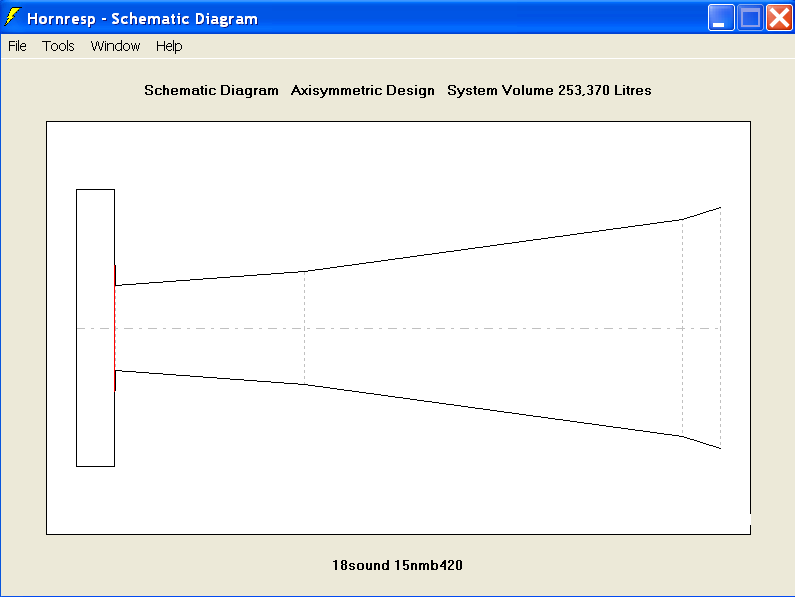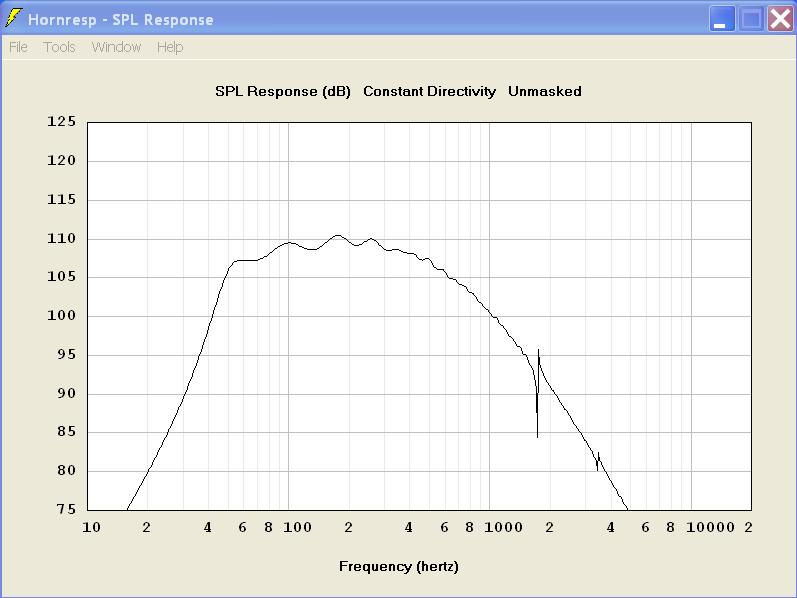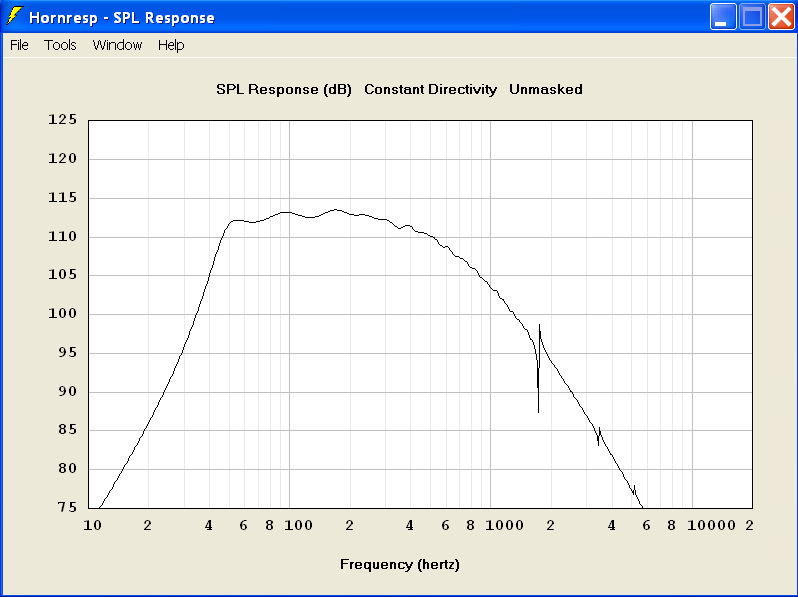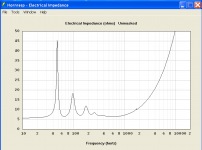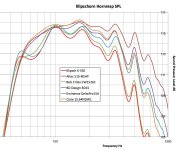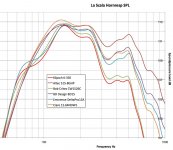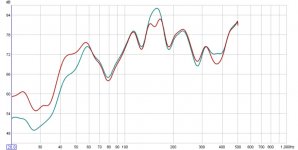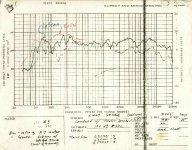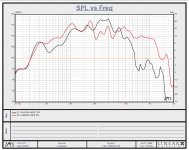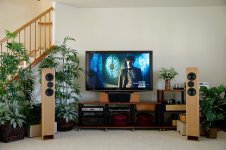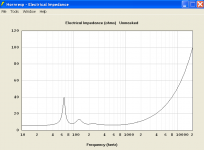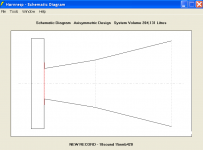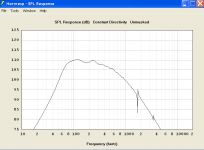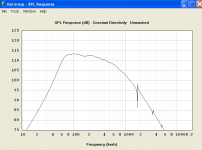 Thread split from http://www.diyaudio.com/forums/multi-way/140190-jean-michel-lecleach-horns.html
Thread split from http://www.diyaudio.com/forums/multi-way/140190-jean-michel-lecleach-horns.html_______________________________________________________________
Hi Lynn,I find it interesting that I've always liked the bass of Klipschorns, Belle Klipsch, and La Scalas, yet I know the frequency response of these folded horns is terrible, with 10~20 dB holes in the response, especially where they struggle to meet the bottom of the modest-sized midhorn. .
10db holes?
here a 2way backloaded horn January 2010. You can also see that on the ripple at 200Hz. Topic http://www.diyaudio.com/forums/multi-way/170024-project-presentation-horn-almighty.html
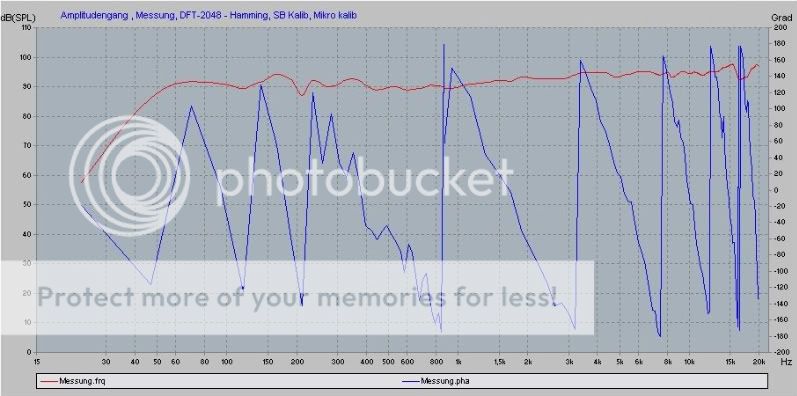
Here the system in stereo measured on listening position it was in fact reasonable flat 30hz -15dB. Only the mid range seemed to change constantly, some day it sounded great and a other day it was not so good any more.
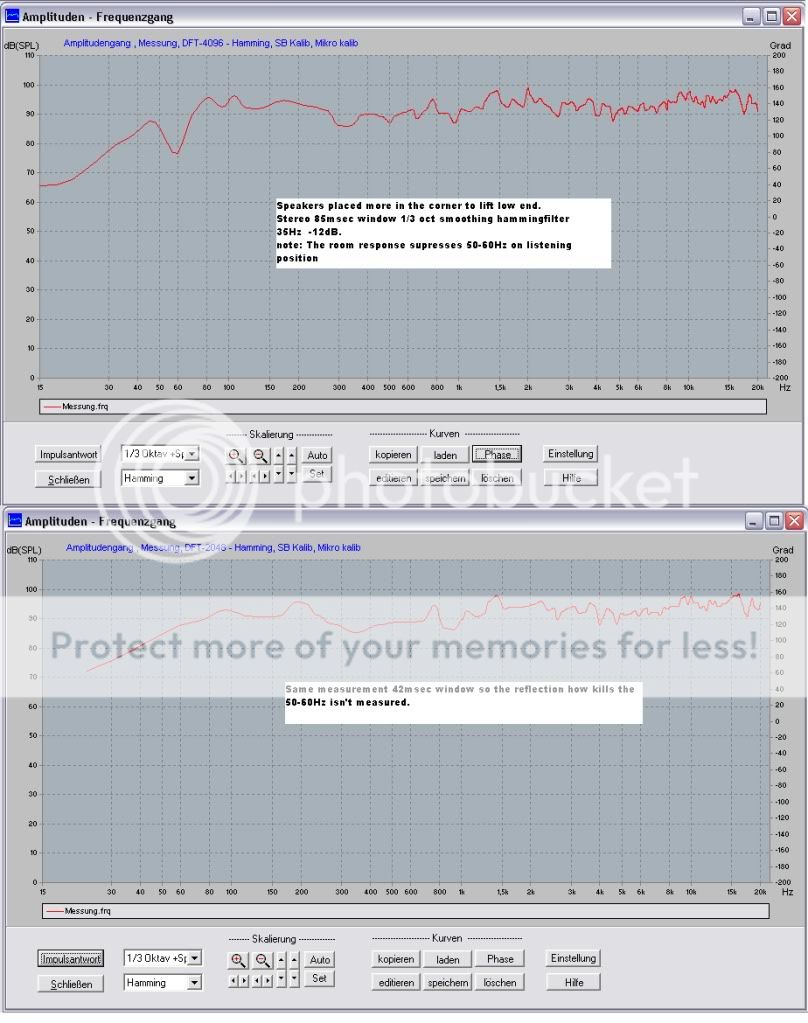
Last edited:
My first horn project data september 2000. The chipwood one was the proto type. (It sounded better the the folded one more sub bass.)
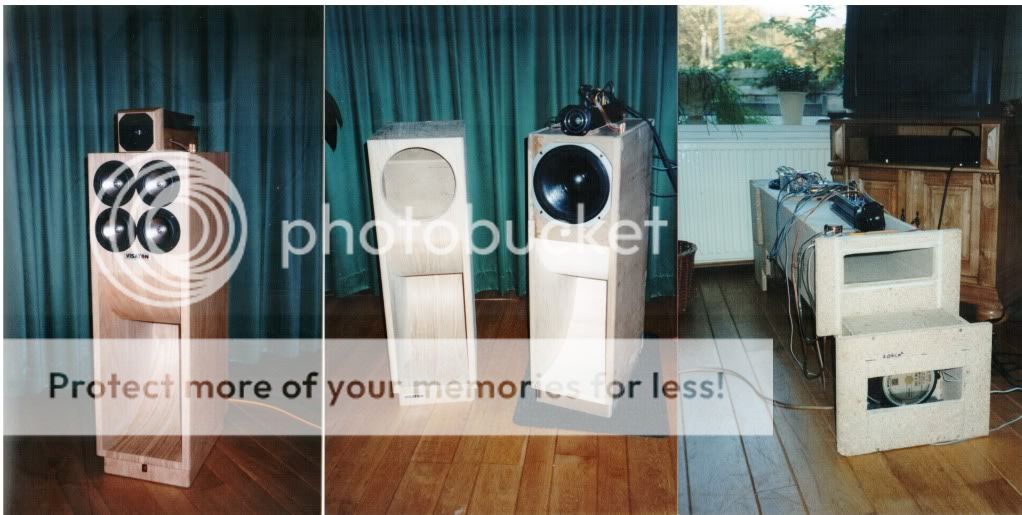
Here the active 2 way titanium horn with a big experiment next to it.

And here the plans of the la scala to show how to fold the horn. 1/4 lambda = about 1 meter! very short, good loading down to 86Hz
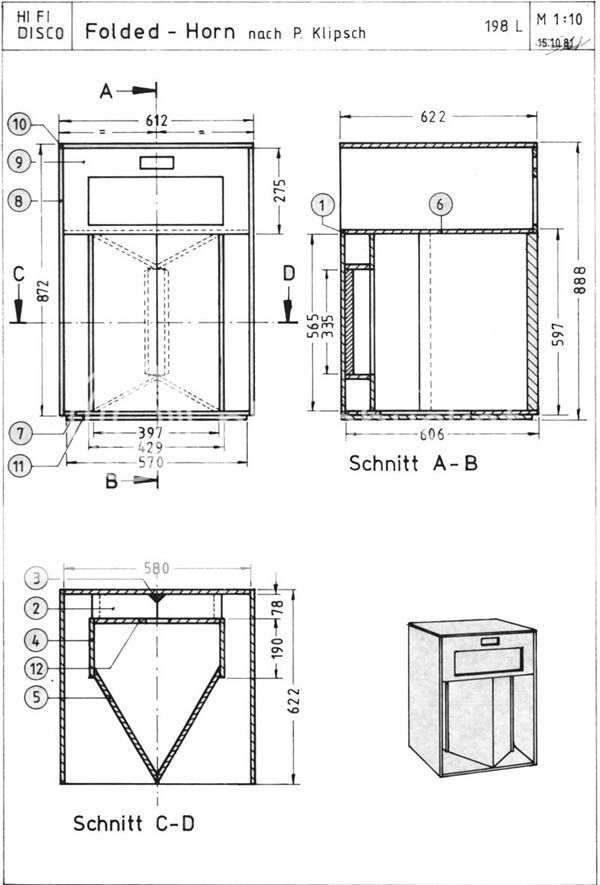
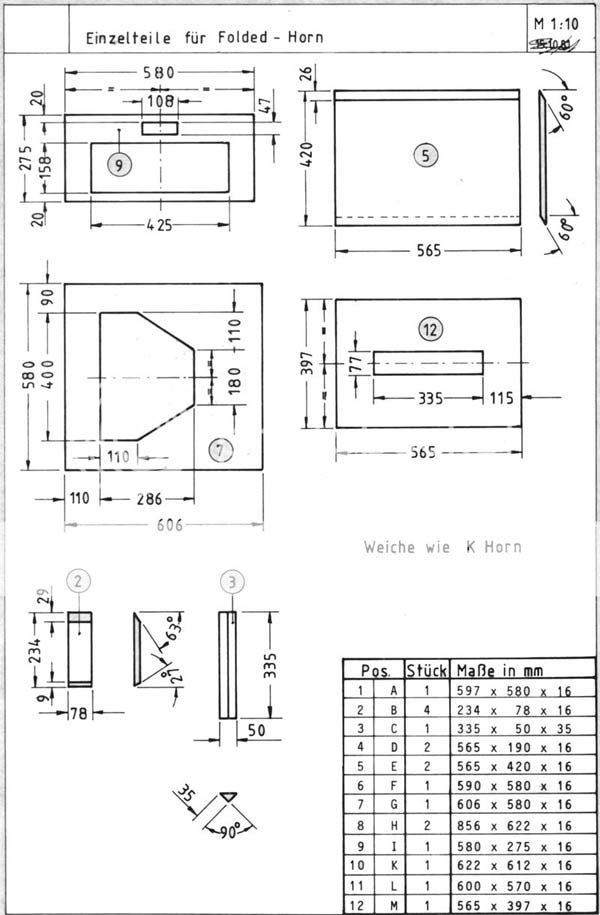
Horn loaded sub gives transparent subbas.

Here the active 2 way titanium horn with a big experiment next to it.

And here the plans of the la scala to show how to fold the horn. 1/4 lambda = about 1 meter! very short, good loading down to 86Hz


Horn loaded sub gives transparent subbas.
Last edited:
Lynn, have you seen/heard Cogent or Goto bass compression driver? This year with Autotech I'm going to release such a driver together with dedicated bass horn.
Hmm ... not really. The few times I've heard Cogent at the RMAF it was a work-in-progress, so I couldn't really assess the sound at all. Combine the wacky acoustics of a hifi show with a loudspeaker that is still in development, and it's hard to tell what the final product in a customer's home is meant to sound like. From my limited exposure, I do like the sound of field-coil drivers, but I'm not sure they sound any better (just different) than Alnico. The Goto's are astronomically expensive, far out of the range of any project I would attempt.
I encourage your project - the typical high-end bass isn't very good. At every hifi show, it's an array of 8, 10, or 12-inch drivers. Over and over and over again. I'm getting very tired of the flat tonal quality of these things, which is not a good match to high-performance mids and HF drivers (such as compression drivers, ribbons, or electrostats). Dipoles help, but they typically require a lot of equalization if the drivers are working over a 1-decade frequency range, which makes them unsuitable for triode amplifiers.
Helmuth, thank you for your kind suggestions. How big is that straight horn, anyway? I suspect it's too large for my living room, and I'm not about to spend $30,000 to convert my unfinished basement to a living space. The curved or folded horns look more possible - something about the size of the La Scala, or maybe the vented-rear-chamber variant somebody came up with a few years ago. I'd like to credit the author of that variation, but I don't recall his name at the moment. Just wondering if there is a modern version (not using the Klipsch parameters or folding scheme) that covers the 70~700 Hz range reasonably well - the La Scala doesn't really go up to 700 Hz, more like 350~400 Hz at most.
Last edited:
Helmuth, thank you for your kind suggestions. How big is that straight horn, anyway? I suspect it's too large for my living room, and I'm not about to spend $30,000 to convert my unfinished basement to a living space. The curved or folded horns look more possible - something about the size of the La Scala, or maybe the vented-rear-chamber variant somebody came up with a few years ago.
Hi linn I am European so I calculate metric.
The la scala is about 295litre.
My simulation is 254 litre it would become the same size as the la scala.
Personaly I would say forget the form of the la scala. and fold it something like this one. This drawing is a cube shape I would make it taler and like this one woofer cone facing the top of the box. And a BR opening in the closed volume.
An externally hosted image should be here but it was not working when we last tested it.
An externally hosted image should be here but it was not working when we last tested it.
Last edited:
Impedance (at 1 phi) of the woofer BR tuning of 45 Hz shout be possible. Then it would out perform the klipschhorn.
15nmb420
15nmb420
An externally hosted image should be here but it was not working when we last tested it.
Attachments
Last edited:
Just wondering if there is a modern version (not using the Klipsch parameters or folding scheme) that covers the 70~700 Hz range reasonably well - the La Scala doesn't really go up to 700 Hz, more like 350~400 Hz at most.
To cover up to 700Hz with a horn of 1.6 meter. It would colour. Use it as sub up to 200-300Hz.
Then XO to the BMS 4591
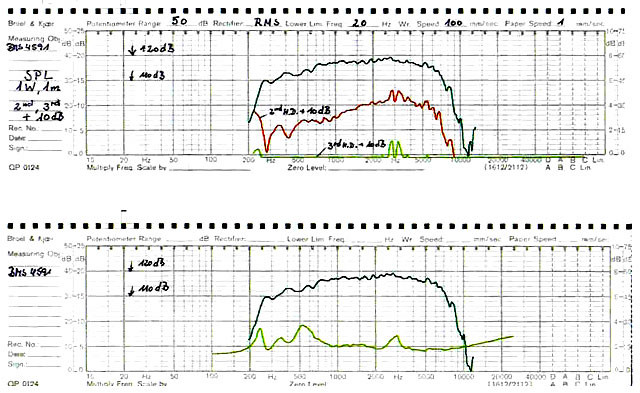
And a super tweeter.
like this one from P-audio and it it has become a improved la scala.
http://www.paudiothailand.com/pdf/products/PHT-409.pdf
So far so good. What would the response out to 700 Hz look like? This is where the La Scala has the most serious problems. For that matter, is any folded horn good up to 700 Hz? Is a smooth curve a better method of folding, or not?
Western Electric used a smooth curve for their earliest fullrange theater horns, but I've never seen any FR curves for these things.
Western Electric used a smooth curve for their earliest fullrange theater horns, but I've never seen any FR curves for these things.
Last edited:
So far so good. What would the response out to 700 Hz look like? This is where the La Scala has the most serious problems. For that matter, is any folded horn good up to 700 Hz? Is a smooth curve a better method of folding, or not?
Western Electric used a smooth curve for their earliest fullrange theater horns, but I've never seen any FR curves for these things.
This can certainly be accomplished with a Klipsch Jubilee bass bin. The design and performance are outlined in a JAES article by Delgado and Klipsch (JAES, 2000). All the cuts are single bevel, so it is more DIY friendly than say a Klipschorn.
I have a picture in my head that the sound wave a pressurization or decompression travels though the shape of your horn. And then you have to think about the 1/4 lambda length of the pressure wave in the horn.So far so good. What would the response out to 700 Hz look like? This is where the La Scala has the most serious problems. For that matter, is any folded horn good up to 700 Hz? Is a smooth curve a better method of folding, or not?
Western Electric used a smooth curve for their earliest fullrange theater horns, but I've never seen any FR curves for these things.
Then I aspect every fold or direction change causes losses. It shout have a smooth shape. Like the drawing three shallow bends so it flows good.
And how do you want to compensate the time loss of the 1.6meter it traveled to the horn mouth. 4,6msec DSP? to fit the mid range.
Sure the klipsch has problems when the XO is 500-600 Hz can only cause big phase problems.
Last edited:
Rummaging through my hard drive, here's a set of curves I've dug up for the various Klipsch basshorns. The first graphic is the Klipschorn, the second is the La Scala, the third is the ported vs sealed La Scala, and the fourth are PWK's measurements of the Klipschorn and La Scala. If I recall right, the Belle Klipsch measures quite similarly to the Klipschorn.
Things don't look good for a 700 Hz crossover with these two horns. 300~400 Hz, sure, if you're willing to live with a rough phase transition between the basshorn and the midhorn. I can see why ALK uses ultra-steep slopes on his aftermarket crossovers for the PWK products.
Things don't look good for a 700 Hz crossover with these two horns. 300~400 Hz, sure, if you're willing to live with a rough phase transition between the basshorn and the midhorn. I can see why ALK uses ultra-steep slopes on his aftermarket crossovers for the PWK products.
Attachments
Last edited:
I can see why some of the early Fifties versions of the Khorn used an Altec 288 with 1005 multicell horn and an Electro-Voice T350 supertweeter. The Jubilee has been redesigned for the better (although I have no idea how it sounds subjectively), but I don't have room for a Khorn.
What's available is about the size of the La Scala in overall volume. To give you an idea of the scale, the display is a Panasonic P58VT25 58" television, about 60" wide overall. Yes, I plan to add damping panels on that 45-degree stairway that intrudes on the living-room space.
What's available is about the size of the La Scala in overall volume. To give you an idea of the scale, the display is a Panasonic P58VT25 58" television, about 60" wide overall. Yes, I plan to add damping panels on that 45-degree stairway that intrudes on the living-room space.
Attachments
Last edited:
I have a picture in my head that the sound wave a pressurization or decompression travels though the shape of your horn. And then you have to think about the 1/4 lambda length of the pressure wave in the horn.
Then I aspect every fold or direction change causes losses. It shout have a smooth shape. Like the drawing three shallow bends so it flows good.
And how do you want to compensate the time loss of the 1.6meter it traveled to the horn mouth. 4,6msec DSP? to fit the mid range.
Sure the klipsch has problems when the XO is 500-600 Hz can only cause big phase problems.
I'd use the folds as an opportunity to break up standing waves and "soften" resonances. With a quarter wavelength of 5 inches, it doesn't seem like a smooth curve (spiral) is going to offer very much over a folded version since radial reflections are unavoidable in both. Perhaps the most sensible approach is to build a prototype and apply a precisely located acoustical filter here or there a la Danley or Von Schweikert?
Lynn those plants got to move for the washing machine size bass horns . 
Simulation with the same driver and as the lascala with short 1meter horn. 1phi it will be better the reproduce up to 300Hz 60Hz not bad at all with this short horn.
Simulation with the same driver and as the lascala with short 1meter horn. 1phi it will be better the reproduce up to 300Hz 60Hz not bad at all with this short horn.
Attachments
Last edited:
Forgive me if this is a stupid question, but what about the range below 60-70 Hz? There's music up to at least 40 Hz, if not lower. Is the idea to put a shelf on the horn so that the response meets the efficiency at 40 Hz or so? Wouldn't the horn be unloaded in this region then?
I've been working on a similar design with a paper mache horn crossed in the 400-700 Hz region to a bass horn. Size is an issue though.
I've been working on a similar design with a paper mache horn crossed in the 400-700 Hz region to a bass horn. Size is an issue though.
- Status
- This old topic is closed. If you want to reopen this topic, contact a moderator using the "Report Post" button.
- Home
- Loudspeakers
- Multi-Way
- Back Loaded Horns
